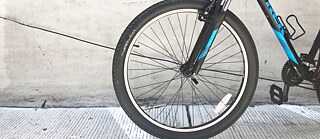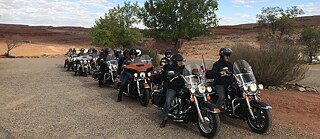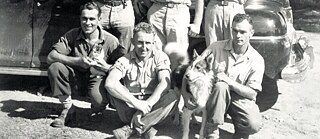Eine fast vergessene Geschichte
Ball Bearings
Kugellager sind überall dort im Einsatz, wo sich etwas fortbewegen soll: in Fahrrädern, Automotoren, Schiffsschrauben sind Kugellager gut versteckt eingebaut und ermöglichen Fortbewegung, ohne dass die meisten von uns überhaupt von ihrer Existenz wissen. In dieser Folge rückt Scott Carrier dieses Meisterstück der Ingenieurskunst ins Rampenlicht und erzählt uns, welche wichtige Rolle es in der Geschichte der Menschheit spielt.
Diese Folge anhören: Apple Music | Spotify | Download
Diese Episode stammt von dem US-amerikanischen Autor und Radiojournalisten Scott Carrier, der unter anderem Beiträge für „This American Life“ und „All Things Considered“ schreibt und produziert. In dieser Folge betrachtet er die Geschichte der Menschheit anhand der 2700 Jahre zurückreichenden Entwicklung des Kugellagers, eine Technik, bei der durch einen Innen- und einen Außenring rollende Körper Reibungswiderstand und damit einhergehenden Verschleiß verringern. Das Foto zur Folge zeigt ein Fahrrad, das sich ohne ein Kugellager nicht fortbewegen könnte.
Transkript
Scott Carrier: I remember when I learned how to ride a bike — five years old, three and a half feet tall. At first, the bike was heavy and awkward, and I crashed into the asphalt more than once. But then, I got it — how to balance and pedal and steer — and I was flying. I realized I had spent my life pretty much as a stationary object, but now, I had wheels and my own velocity. I could turn in circles or go fast in a straight line. It felt like freedom. It felt like magic. At that time, I did not question how it could be that a five-year-old could zip around like a bird with very little effort or restraint. I took it for granted. Bicycles existed, therefore I would ride them for fun because I could. When my bike broke down — anything other than a flat tire — I didn’t know how to fix it. Eventually, I’d get a new one. I was ignorant of the machine, the way the magic actually worked.
When I was 19, I moved away from home to go to college. I didn’t have a car, so I needed a bike, and there was a bike shop across from campus. I went in and told the long-haired mechanic I wanted a bike that turns well at high speeds and doesn’t break down. He brought out a Motobécane, red and black, made in France. I rode it and fell in love. The mechanic, however, warned me about the bike not breaking down. He said: This is a good bike, with good components, but even the best bikes need to be maintained. Bicycles, he told me, are the most efficient form of transportation by far because they roll on ball bearings. All the moving parts — the wheels, the pedals and cranks, the steering column — they all spin on ball bearings. You can’t see them, he said. They’re hidden inside — rings of steel balls spinning inside doughnut-shaped shells or, actually, it’s more like they’re sandwiched between two sides of a bagel. He held his hands like he was holding a bagel together. Too tight, he said, and the balls don’t spin. Too loose, and the balls wobble. But in between, there’s a magic spot, where there’s no friction.
He picked up a bike wheel lying on his bench, told me to hold it by the axle, one hand on each side, and he gave it a spin. He said: A guy brought in this wheel because it was wobbling because it had loose bearings. The bike wheel in my hands felt like it was spinning on butter — silently, no vibrations. The mechanic said, I adjusted the bearings, now it’s good. He told me the bearings in my bike were also good for now, but eventually, they’d all go out of alignment and need to be adjusted. It’s just the way it is, he said, so it’s time you learn how to maintain your bearings. I bought the bike and a bunch of tools, the ones he said I needed.
I don’t remember how long it was after that or why specifically I started taking the bike apart, but there came a moment when the bike was in pieces, and I had a hundred steel balls rolling around on my kitchen floor. I’d rendered a perfectly functioning machine into chaos, and I thought, this may not end well.
It turns out, ball bearings are all around us inside all our wheels and motors. We don’t see them in action because they’re hidden, enclosed by design. But they’re here, inside our fans and vacuum cleaners and jet engines as well as our bicycles, cars, and trucks. They’re literally how we roll. Without ball bearings, civilization as we know it would come to a very loud and grinding halt. And yet, we give them very little recognition or respect. We don’t think about where they come from or how they got here. We don’t even know we’re dependent upon them.
There are many kinds of bearings. Some have balls or roller elements, and some do not. The thing they all have in common is their function, which is to reduce friction. Today, this is what we need and want — less friction. But for most of human history, friction was not a problem, not something that needed to be reduced or overcome. Friction used to be a good thing. It’s how we kept from slipping while walking. It’s how we built our fires.
But then about 10,000 years ago, people started moving large rocks across the ground to build sacred, megalithic monuments. We’re talking about rocks the size of elephants and whales, often transported many miles to build structures that connected the earth to the sky, structures that had magical powers. This is when friction first became a problem, and it’s how our dependence on bearings began. They were Stone Age people, meaning they had only stone tools to work with. Horses were not yet domesticated. The huge boulders they moved and placed are still standing across Europe, Africa, Asia, and islands in the Pacific Ocean. Nobody knows for sure why they did it because they didn’t write things down. There was no written language back then. So, we also don’t know for sure how they did it, but there seems to be only one possibility.
Think of Stonehenge, built 4,600 years ago on what is now the Salisbury Plains of England. The tall standing stones in the outer ring are 13 feet high and seven feet wide, four feet thick, each weighing 30 tons, and they come from a quarry 20 miles away. Imagine we’re standing there in that quarry, 4,600 years ago, looking at one of the stones lying on the ground. It’s 13 feet long, weighs 30 tons, and we’re wondering how we’re gonna move it even one foot — let alone 20 miles. We have one basic problem — too much friction. Friction comes from surfaces sliding or rolling over each other. The more surface area coming into contact, the more friction is created. If our stone were shaped like a ball, it wouldn’t have much surface area touching the ground, and we could roll it. But instead of a ball, we have a long slab. To slide it across the ground seems impossible. Our only hope is to lower the amount of surface area coming into contact between the rock and the ground. Some of you may have already come up with the answer — we use smooth logs as roller pins under the rock. We chop down some trees with our stone axes and smooth out the trunks and put them under the rock, one after the other. The rock doesn’t touch the ground, it rides on the roller logs — a huge reduction in friction. This is how we think they did it. We don’t know for sure, but the only other answers are by magic or aliens. These were the first bearings, the first step in overcoming the forces of friction. We now call them roller bearings, and we still use them in conveyor belts.
The second big innovation in reducing friction was the invention of the wheel, or I should say the invention of the wheel and axle, because they always go together. Again, this innovation happened in different places at different times during the Late Stone Age, starting about 5,000 years ago. And again, there’s no record of how the innovation came about. But if you were a Stone Age person with some experience moving huge boulders on roller bearings, it might not be such a great leap of the imagination to wonder what it would be like if you took one roller log and made it into an axle with two wheels spinning on the ends. This reduces the surface area coming into contact — down from the entire length of the log to just where the wheel spins around it. This place where the wheel spins around the axle, that’s the bearing. Back then, it was a new bearing — we now call it the plain bearing. Wheels and axles would not have worked for transporting huge boulders — the weight would have broken the axles. The earliest wheels we’ve found were used for wheelbarrows and hand carts. They were most likely built by agrarians, farmers, trying to save their backs.
Some of these early wheels are solid stone, some are solid wood. They now look very crude like they were made by children. But just think about it for a minute — how are you going to make a wheel, or two wheels and an axle, if you only have stone tools to work with? You can pound a rock with another rock to make it round and then somehow grind a hole through the center. You can chop away at a tree limb to make an axle that fits through the hole, but the wheel’s going to grind and rub on the axle. And in the end, you’ll have a vehicle that’s heavy, difficult to push uphill, and hard to hold back coming down. Stone Age wheels pretty much sucked.
In order for wheels to get better, two things had to happen: People had to figure out how to work with metal, and they had to domesticate the horse. Both of these things happened during the Bronze Age, 5,000 to 3,000 years ago. They made bronze by melting tin with copper, and then, they formed it into wheel hubs and axles — bearings that were strong and smooth. With metal knives, they fashioned wood spokes and wood rims that were thin and lightweight, at least compared to Stone Age wheels. Then, they built chariots, carts, and carriages and tied them to horses.
For thousands of years, the methods and practice of building wheels remained essentially the same. All wheels and axles came together in plain bearings — a metal hub spinning around a metal axle — and all vehicles were pulled by humans or horses or other beasts of burden. I believe these were the dark ages of the bearing. From the early chariots, 5,000 years old, all the way up to the American stagecoach of the 1860s, there were no major innovations to overcome the forces of friction. Wheels were used for work, commerce, and war. They did more to enslave us than to set us free.
All this changed in 1869, when a French bicycle mechanic named Jules Suriray designed and built ball bearings for a bicycle wheel. After thousands of years, it was the bicycle that was the great leap forward in the evolution of bearings and the reduction of friction. Suriray did not invent the ball bearing, he was just the first person to build one that actually worked for a wheel and axle. The first ball bearings we’ve found come from two submerged Roman ships, big party boats circa 50 AD. On the decks, there were rotating platforms about four feet in diameter. Between the platform and the deck, there was a ring of iron balls, each ball spinning in its own cup. That’s a bearing that uses balls, so it counts as a ball bearing. We don’t know what was on top of the platform, turning around on a deck of a party boat large enough to hold 200 people. But in my mind, it’s a statue of John Belushi in a toga.
Then in 1499, Leonardo da Vinci included a ball bearing in his design for a helicopter. Instead of rotating blades, the helicopter had a spiral sail. The sail spun on a mast that was hand-cranked by four men sitting on a platform. And at the base of the mast, there was a ball bearing to reduce friction. Da Vinci never built his helicopter, and it wouldn’t have worked anyway, but the ball bearing he drew on paper looks very much like ball bearings today.
Somebody, probably a lot of people, thought about using ball bearings for carriage and wagon wheels. The concept was known. To build a ball bearing, however, was quite difficult. The balls had to be the exact same size, perfectly round. They had to spin in perfect doughnut-shaped shells. And the two sides of the shell — one attached to the wheel, the other to the axle — they had to be held in an exactly perfect position — not too tight, not too loose. All this involved a big learning curve of design and craftsmanship. So, it took a long time.
In 1794, early Industrial Revolution, the Welshman Phillip Vaughan patented a ball bearing for a carriage wheel. Vaughan worked as a designer at a steel mill in Carmarthen, Wales. He advertised in the local paper that his new ball bearings would allow one horse to pull what used to take three horses, boasting of their efficiency. Apparently, public interest was lacking because there’s no evidence that Vaughan ever made or sold even one of his wheels. And it was not a good design to begin with — difficult to build and maintain, unstable, prone to failure.
In 1815, 21 years after Vaughan’s poor ball bearing premiere, things changed in a very unexpected way — starting with the record-setting eruption of Mount Tambora in Indonesia. The volcanic ash sent into the atmosphere blanketed the skies of northern Europe for two years. This led to crop failure and famine wherein many horses died of starvation or were eaten as food by humans. One result was that lots of people were forced to walk wherever they wanted to go.
This is when German inventor Karl von Drais came out with a new kind of personal transportation. He called it the ‘running machine.’ It was like a bicycle, but it had no pedals. The frame was wood, the wheels were wood, with plain bearings. You could steer it, but to make it go forward or backward, you had to walk or run your feet along the ground. On flat ground, you could go about ten miles an hour, but the running machine had to be pushed uphill, and coming down, the brakes were marginal. And yet, they were very popular. By 1817, people all across Europe were running-machining themselves across the ground. Then, the sky cleared up, the crops came back, people stopped eating horses, and it seemed the only folks on running machines were obnoxious young men, some with no regard for the safety of pedestrians.
The running machine fell out of fashion, but improvements continued to be made to its design, especially by the French, who called it the ‘vélocipède.’ By 1860, vélocipèdes in Paris had rather beautiful lightweight steel alloy frames. And in 1868, Parisian blacksmith Pierre Michaux finally came up with the idea of pedals. He put them on the front wheel, and the bicycle was born. The early bikes had big front wheels because that way they’d go farther and faster for every turn of the pedals.
By 1869, there were young men racing bicycles all around Paris. People called the bikes ‘bone-shakers’ for all the banging and bouncing over cobblestone roads. These banging and bouncing forces went first to the plain bearing in the front wheel and then through the steel frame to the bones of the rider. Bearings wear out, just like lower vertebrae. The moving parts need to function as a unit — everything staying the right shape and size in alignment — while moving across the ground and being subjected to the forces of gravity and lateral accelerations. You can start off with everything working really well, but eventually, friction is going to create heat, which causes swelling, which causes more friction, and the unit is going to fall apart, especially if there’s banging and bouncing involved.
We know Jules Suriray was a bicycle mechanic in Paris. But unfortunately, very little is known about his personal history or how he came up with his ball bearing design. I assume, or I imagine, that young men around Paris brought Suriray their broken bicycles and asked him to fix them, so they’d go even faster. Suriray looked at the bicycles and realized their front wheel bearings were wearing out from friction and abuse. If he could reduce the friction, the bike would go faster and last longer. Maybe he’d seen Da Vinci’s plans for a helicopter. Maybe he’d studied Vaughan’s patent for carriage wheels and figured out how to improve the design.
We know there was a big race coming up, November 5th, 1869 — the first long-distance bicycle race across the countryside, Paris to Rouen, 80 miles. Suriray was in his shop, working on a wheel with ball bearings for the race. He hand-filed the steel balls and then used a lathe to make two round half shells, and then, he figured out how to hold them in the right place — not too tight, not too loose — so the balls spun freely between the axle and the wheel. His design was simple, and it worked very well. It’s basically the same design we use today. It must have felt really good when he gave the wheel a spin. It may have felt like magic.
120 riders showed up at the Arc de Triomphe for the start of the race. The only rules were: You couldn’t use a sail or be chased by a dog. The course followed bumpy country roads with uphill sections, where the bikes had to be pushed. On Suriray’s bicycle was the 20-year-old Englishman James Moore, one of the hot-shot racers around town. There were two women racers, one who called herself Miss America. First prize was 1,000 francs and a free Michaux bicycle. 34 riders finished the race, including Miss America. James Moore came in first, crossing the finish line 15 minutes ahead of the second and third riders. His time was ten hours and 45 minutes, an average speed of only seven and a half miles an hour. But it would have taken four days to walk, probably three days on a horse. James Moore became famous, and Suriray went into business making bicycle wheels that turned on ball bearings. Then in 1870, only a year later, the Franco-Prussian War began, and Paris became a war zone. Nobody there was interested in bicycles anymore.
Bicycle manufacturing moved to Germany, England, and the United States. Ball bearings became standard parts but making them was still difficult, especially the steel balls, as they had to be shaped and filed by hand, one at a time. In 1883, a German named Friedrich Fischer, invented the ball-grinding machine that could produce large numbers of steel balls with fine precision, varying no more than 0.02 of a millimeter.
By 1890, bicycles looked and handled pretty much like they do today. The front and back wheels were the same size, and they had inflatable rubber tires. Pedals were in the middle of the frame with a chain to the back wheel, and all moving parts except the brakes turned on ball bearings. They called it the safety bicycle because it was a lot safer and easier to ride than the bone-shaker.
By the mid-1890s, a bicycle craze was sweeping across Europe and the United States. There were hundreds of bicycle manufacturers and millions of people riding them because bicycles gave people a new sense of freedom, especially women. With a bicycle, a woman could come and go as she pleased. She no longer needed a man with a horse in order to get around. In 1896, women’s rights advocate Susan B. Anthony wrote: Let me tell you what I think of bicycling. I think it has done more to emancipate women than anything else in the world. And at the end of the decade, the U.S. Census Report proclaimed: Few articles ever used by man have ever created so great a revolution in social conditions. Women who rode bicycles started demanding equal rights like the right to vote. You might say ball bearings went to their heads — they wanted to be free without friction in all parts of their lives, not just when they were on a bicycle. All this changed, however, at the turn of the century, when mass production of affordable automobiles put men back in the driver’s seat.
Ball bearings were used in automobiles and then in airplanes as well as in electric generators and electric motors. Without ball bearings to reduce friction, the spinning parts of these new machines would have heated up and seized together. In this way, ball bearings became essential in our culture, a way like water is essential in our bodies. An illustration of this would be the bombing of Schweinfurt during the Second World War. At that time — 1943 — the city of Schweinfurt produced approximately 50% of the ball bearings spinning inside the Third Reich’s war machine. The strategy, therefore, was to cripple the war machine by bombing the ball bearing factories.
On the morning of August 17, 1943, 230 American B-17 bombers took off from England headed across the Channel towards Schweinfurt, Germany. The bombers flew in a formation that stretched for 20 miles, blanketing the sky. Once over the continent, they were intercepted by German Messerschmidt fighter planes that began shooting them down. All these planes had ball bearings surrounding their propeller shafts. It was a battle of, by, and for ball bearings. The factories were hit but suffered only temporary damage, while the Americans lost about a quarter of their planes and a quarter of their crewmen — either killed or taken prisoner. Clearly, the bombing mission had not been a success. So, they did it again and again — 22 times in all. And yet, the German war machine never suffered for ball bearings.
Today, we have most excellent bearings that ride on roller pins and roller cones as well as balls. We even have bearings that ride on fluids and air. For instance, the disc in my laptop computer spins on an air bearing, where no solid surfaces come into contact, reducing friction to almost nothing. Today, friction is no longer a problem that needs to be solved. Our problem now is we have too many wheels and motors spinning all around us. We’ve grown dependent upon them and the fossil fuels that keep them spinning — we need and want more and more and more and more — while glaciers recede, and species go extinct.
What we really need now is a new kind of bearing, one that’s purely conceptual, a bearing that could hold together two opposing thoughts or beliefs — like science and religion, or us and them — hold them together in a way they can move without friction. Jesus and Buddha thought compassion can work like this, as a conceptual bearing, but compassion always seems to be in short supply or not around when you need it.
It’s been 46 years since I was in college staring at the steel balls scattered on my kitchen floor, and I must confess that I have yet to master the art of maintaining my bearings, of finding the perfect spot — not too tight, not too loose — but I’m working on it.







